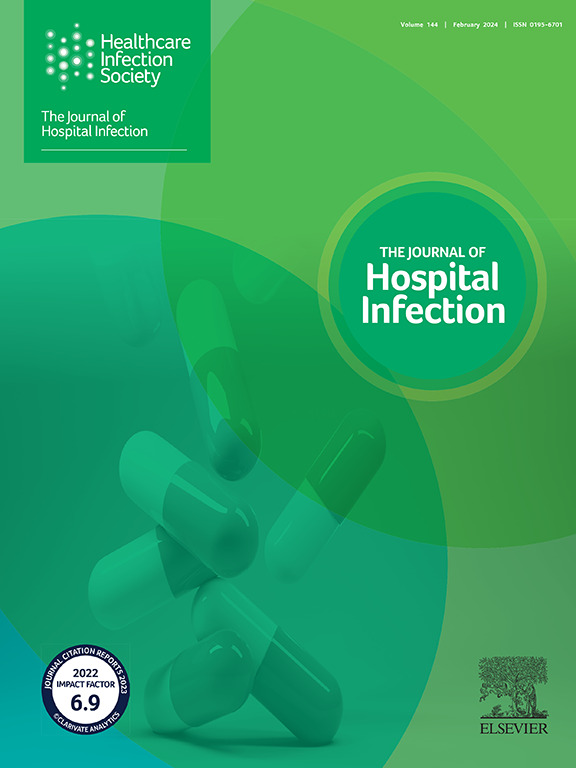Chicken or egg? The role of dysbiosis in intestinal carriage of carbapenemase-producing Enterobacterales
IF 3.1
3区 医学
Q1 INFECTIOUS DISEASES
引用次数: 0
Abstract
Background
Carbapenemase-producing Enterobacterales (CPE) have a well-established capability of spreading in healthcare environments and cause outbreaks in hospital wards.
Aim
To determine whether intestinal dysbiosis is associated with intestinal carriage of CPE; also to investigate treatment with antibiotics, and hospitalization prior to study inclusion.
Methods
A systematic search of the PubMed, Embase, and Cochrane databases was conducted in September 2024, and studies were included where the authors compared microbiome analysis of CPE carriers with microbiome analysis of non-carriers.
Findings
The search resulted in 1812 records. After removing duplicates, and non-eligible records based on title and abstract screening, 67 records were retrieved for full-text screening. Of these, four studies were included in the systematic review including 140 CPE carriers and 141 controls. In three studies the authors found dysbiosis in the group of CPE carriers, and in the fourth study they found a decrease in diversity in CPE carriers compared with healthy adults; however, there was no decrease in diversity compared with hospitalized non-carriers.
Conclusion
This systematic review has revealed an association between intestinal dysbiosis and intestinal carriage of CPE. Nonetheless, the potential influence of antibiotic treatment on this result cannot be dismissed.
鸡还是蛋——产碳青霉烯酶肠杆菌肠道运输中生态失调的作用。
背景:我们旨在确定肠道生态失调是否与产碳青霉烯酶肠杆菌(CPE)的肠道运输有关。作为次要目的,我们调查了纳入研究前的抗生素治疗和住院情况。方法:我们于2024年9月对PubMed, EMBASE和Cochrane数据库进行了系统回顾,我们纳入了作者比较CPE携带者和非携带者微生物组分析的研究。结果:我们在PubMed、EMBASE和Cochrane数据库中检索了1812条记录。在删除重复和基于标题和摘要筛选的不合格记录后,我们设法检索67条记录进行全文筛选。其中,四项研究纳入系统评价,包括140名CPE携带者和141名对照组。在三项研究中,作者发现了CPE携带者组的生态失调,在第四项研究中,他们发现与健康成人相比,CPE携带者的多样性减少,但与住院的非携带者相比,多样性没有减少。结论:在本系统综述中,我们发现了肠道生态失调与CPE肠道运输之间的关联。尽管如此,抗生素治疗对这一结果的潜在影响不能被忽视。
本文章由计算机程序翻译,如有差异,请以英文原文为准。
求助全文
约1分钟内获得全文
求助全文
来源期刊

Journal of Hospital Infection
医学-传染病学
CiteScore
12.70
自引率
5.80%
发文量
271
审稿时长
19 days
期刊介绍:
The Journal of Hospital Infection is the editorially independent scientific publication of the Healthcare Infection Society. The aim of the Journal is to publish high quality research and information relating to infection prevention and control that is relevant to an international audience.
The Journal welcomes submissions that relate to all aspects of infection prevention and control in healthcare settings. This includes submissions that:
provide new insight into the epidemiology, surveillance, or prevention and control of healthcare-associated infections and antimicrobial resistance in healthcare settings;
provide new insight into cleaning, disinfection and decontamination;
provide new insight into the design of healthcare premises;
describe novel aspects of outbreaks of infection;
throw light on techniques for effective antimicrobial stewardship;
describe novel techniques (laboratory-based or point of care) for the detection of infection or antimicrobial resistance in the healthcare setting, particularly if these can be used to facilitate infection prevention and control;
improve understanding of the motivations of safe healthcare behaviour, or describe techniques for achieving behavioural and cultural change;
improve understanding of the use of IT systems in infection surveillance and prevention and control.
 求助内容:
求助内容: 应助结果提醒方式:
应助结果提醒方式:


